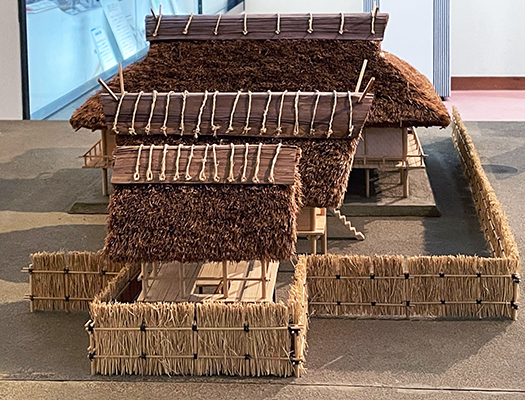


卑弥呼と魏志倭人伝の条にこのブログ連載として突入しております(笑)。
国立歴史民俗博物館の大リニューアルでもこの条については扱いは小さい。
むしろ考古発掘の方に淡々と展開しているようにみられます。
それが現代としてのたぶん理性的な対応だろうと考えます。
なんですが、ここ最近の探訪経験・多数の現場探訪をしてみると、
やはり日本王権の始原期についてある推論が確からしく思えてきます。
それが魏志倭人伝中の「卑弥呼」は王権神話のアマテラスではないかという論。
魏志倭人伝を記述した人物にして見ると、極東の島国について
その国家の輪廓を簡潔に記録する必要がある。
しかしあくまでも自分の目と耳で確認した事実ではなく伝聞情報に基づいている。
3世紀中葉の政権としてのヤマト政権の情報を記述するとすれば
まずはどのような正統性を持った「国体」かが主要なテーマ。
日本側との「外交接触」ではヤマト政権との対話機会が増えていって
政権の「正統性」について確認するのが一般的常識。
その質問に対して外交団側から、アマテラスによる国体草創譚が語られた。
「そのアマテラスという存在はどういう役割を担っていたのか?」
「彼女は太陽の運行を予言し司る立場、いわゆる日の巫女である」
「なるほど、水田稲作にはそういう存在が欠かせないだろうな」
「そうです、いつ田に苗を植えるかは国の大本の決定事項です。」
「さらに稲の生育にあわせていろいろな農事の時期を決定しなければならない」
「そうか、貴国にはわが国以上に明確な四季変化があるのだったな」
「もちろん通常の政務、まつりごとは男性の王が仕切っているけれど、
そういう神意を司るのは、巫女の最高権威がふさわしいのです」
「そうかわかった。しかし、中国側としては皇帝絶対の国柄なので
そのような貴国の国体をわが国の正史で是認するワケにはいかない。」
「なので、わかりやすく貴国を女王の支配する国と記述することにする。」
「アマテラスの表記を天照大神とすることには中国政権として差し障りがあるので、
申し訳ないが卑弥呼という表記としたい」
「う〜む、巫女を弥呼と書くのは理解するが日を卑とするのは・・・」
「そこは中華皇帝国家として東夷の国のことなので了解してほしい」
「それと魏の国をはるかに超える国家神話を持つ国とは表現できないので
卑弥呼の没年についても近年のことと表記することにする。」
・・・というような仮想外交交渉が想像できるのではないか。
日本側・ヤマト政権側としても先方の国家主権・建国事情に関わるので、
最終的には了解することになったのではないか。
以上が大筋の妄想。易姓革命を経たあとの直前の王朝国家記録でもあり
記述についてのここまでの交渉があったとはとても思えないけれど、
伝聞情報の取捨選択判断においてこのような消息はあり得たのではと思う。
魏志倭人伝の書かれた時代の日本の王権の所在場所としての
奈良県纏向遺跡の様子が上の写真群。第10代の崇神天皇の時代に相当し
それまでの王宮でのアマテラスとの同居を停止して
アマテラスはやがて伊勢に遷宮していく直前の王宮復元ジオラマが
桜井市立埋蔵文化財センターで展示されていたものです。
以下、明日は箸墓古墳について、であります。
English version⬇
Himiko = The Miko of the Sun “Amaterasu” The 37,000-Year History of the Japanese Archipelago – 45
Imaginary Reconstruction of the Diplomatic Negotiation Process over the Myth of the Founding of the Yamato Kingdom and the Chinese Orthodox History in the Age of Wei-Shi-Wa-jin-Den. …
We are plunging into the article on Himiko and the Biography of Wei Wei as this blog series (see below).
The National Museum of Japanese History’s major renewal of this article is also treating this article in a small way.
Rather, it seems to be deployed in the archaeological excavation in a lighthearted manner.
We think that this is probably the rational response of the modern era.
However, after my recent experience of exploration and many site visits, I have come to realize that the following is not so much about the origin of the Japanese kingship as about the origin of the Japanese people.
However, after my recent experiences and numerous field trips, I have come to believe that a certain theory about the primitive period of the Japanese kingship seems to be plausible.
That is, the “Himiko” in the Wei-Shi-Wa-jin-Den could be the Amaterasu of the myth of kingship.
The person who wrote the Wei-Shi-Wa-jin-Den briefly describes the shape of an island nation in the Far East.
It is necessary to briefly record the rings of that nation.
However, it is based on hearsay information, not on facts confirmed by his own eyes and ears.
If we were to describe the information on the Yamato regime as a government in the middle of the 3rd century
First of all, the main theme is what kind of legitimacy the “national government” had.
In “diplomatic contacts” with the Japanese side, there were more opportunities to talk with the Yamato regime and
It is common practice to confirm the “legitimacy” of the regime.
In response to this question, the diplomatic corps told the story of the founding of the state by Amaterasu.
What role did this Amaterasu play?
She is the so-called “miko of the sun,” a position that predicts and governs the movement of the sun.
I see. Such a being would be indispensable to paddy rice cultivation.
Yes, when to plant the seedlings in the rice paddies is a decision made by the head of the state.
Furthermore, the timing of various agricultural activities must be determined according to the growth of the rice plants.
I see that your country has four distinct seasons, even more so than ours.
Of course, the king, a male king, is in charge of the normal affairs of government and festivals.
“Of course, the male king is in charge of ordinary government affairs and festivals, but it is appropriate for the highest priestess authority to preside over such divine will.
I see. However, as for the Chinese side, the emperor is the absolute ruler of the country.
“However, since China is a country where the emperor is the absolute ruler, we cannot allow such a state of affairs in our official history.
“So, for simplicity’s sake, I will describe your country as a country ruled by a queen.
“Since the Chinese government is not comfortable with the use of Amaterasu as Amaterasu, we have decided to use the name Himiko.
“I am sorry, but I would like to use the term Himiko.
“Hmm, I can understand writing Yayoi for miko, but Himiko for Hi…”
“I hope you understand that this is a country of the eastern barbarians as the emperor state of China.
“And since it cannot be described as a country with a national mythology that far exceeds that of Wei…
I will also refer to Himiko’s death as being in recent years.
We can imagine a hypothetical diplomatic negotiation like this.
The Japanese side and the Yamato government may have finally come to an understanding on this matter, since it concerns the sovereignty of the other side and the circumstances of the founding of the nation.
The Japanese side and the Yamato regime may have finally agreed to it.
The above is my main delusion. It is also a record of the dynastic state immediately before the Yi Surname Revolution.
I do not believe that there was much negotiation about the description.
However, I think it is possible that there was such a negotiation on the description, but I think it is possible that there was such a disappearance in the decision to discard hearsay information.
The Muzumukai site in Nara Prefecture as the location of the Japanese kingship in the period when the Wei-Shi-Wa-jin-Den was written.
The above photos show the site of the Mimatsuki ruins in Nara Prefecture. It corresponds to the period of the 10th Emperor Sojin, and
stopped cohabiting with Amaterasu in the royal palace until then.
Amaterasu eventually moved her palace to Ise.
This diorama was displayed at the Sakurai Municipal Center for Archaeological and Cultural Properties.
Tomorrow, we will discuss the tomb of Chopstick Tomb.
Posted on 12月 17th, 2022 by 三木 奎吾
Filed under: 日本社会・文化研究, 歴史探訪







[…] ことでほぼ確定されつつある。(纏向遺跡については第45回目の「卑弥呼=日の巫女「アマテラス」論 日本列島37,000年史-45」にて。 しかしそれ以前の古代の大和平野の痕跡も、現地を歩 […]